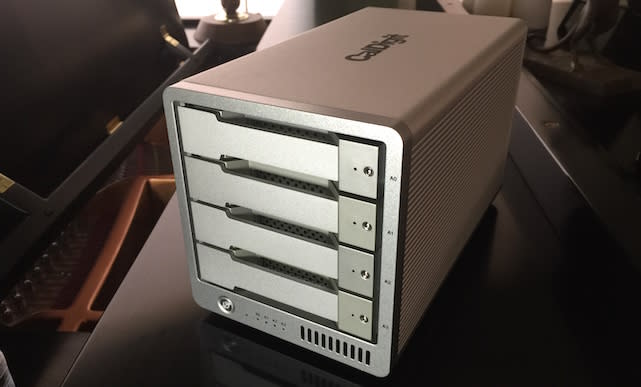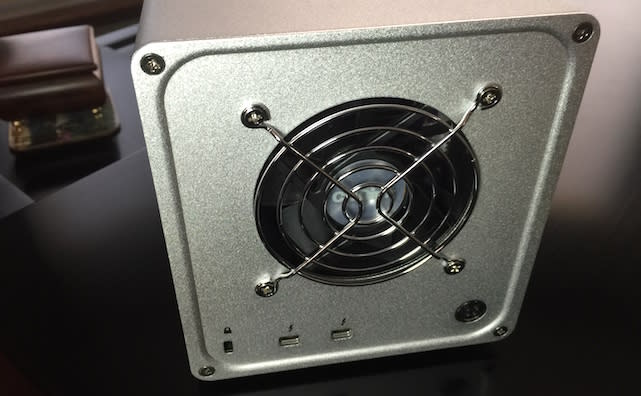CalDigit T4 RAID: Big, fast storage in a compact enclosure

Speed and storage capacity are the qualities that creative professionals look for in a RAID array, and they're willing to pay a lot for the ability to store huge amounts of video or photographs on a fast and redundant unit. CalDigit is now shipping a very affordable 4-bay storage solution called the T4 RAID that comes in a variety of capacities: 4 TB (US$899), 8 TB ($1,199), 12 TB ($1,399), 16 TB ($1,699), 20 TB ($1,999) or 4 TB SSD ($3,299). I had a chance to put a T4 through our standard benchmarks and found it to be a speedy, quiet and sturdy high-capacity RAID array.
Specifications
Weight: 7.2 lb. (3.3 Kg) with 4 SSD installed, 12.5 lb. (5.65 Kg) with 4 HDD installed
Dimensions: 5.8 x 5.3 x 9.5 inches (148 x 135 x 242 mm)
Interface: Two Thunderbolt 2 ports with transfer rates up to 20 GB/s
RAID: Supports RAID 0,1,5 and JBOD, auto disk failure detection, hot swappable disks
Design
The T4 is surprisingly small for a 4-disk RAID array. The entire case is machined out of aluminum, with an appearance similar to that of the T3 3-drive array that I reviewed earlier this year. As with the T3, the drives (either SSDs or HDDs) come in proprietary drive modules. Those drive modules come in a variety of sizes: hard disk drives in capacities of 1 TB ($129), 2 TB ($179), 3 TB ($229), 4 TB ($299), 5 TB ($399), and a 1 TB SSD ($799). These drive modules are also compatible with the CalDigit T3 and the AVPro.
There are some tiny keys that are included to lock the drive modules into place for extra security, and there's a Kensington lock slot on the back of the case. Both are nice physical security features that aren't commonly found on other RAID arrays.

The small size comes at the cost of a good-sized external power supply; usually, that's going to sit under your desk with all of the other power supplies. Although the T4 has a built-in fan to keep those drives cool, it's surprisingly quiet. During testing the drive was about two feet away from me at ear level and all I could hear was a faint white noise. This was an 12 TB HDD configuration that was tested, and there was absolutely no drive noise that I could discern.
With a quiet drive like this, you'll want to have some indication that it's actually working and a set of tiny blue LEDs on the front of the array perform that task without being too bright or distracting. CalDigit includes a monitoring app that's also useful for setting up your array. That app includes some useful tools for benchmarking video throughput to the drive.
Functionality/Benchmarks
Like the T3, the CalDigit T4 is easy to set up. You simply plug a Thunderbolt cable into your Mac and into one of the two Thunderbolt 2 ports on the back of the T4. Plug in the AC adapter, then plug the cable from the power supply into the T4. Turn on the T4 with the front-mounted power button and it spins right up.
The array can be set up as RAID 0 (stripe set), RAID 1 (mirror set), RAID 5 (block-level striping with distributed parity) or in a JBOD ("just a bunch of disk") array with no RAID functionality. Our benchmarking was done with the array set up in RAID 0 with a total volume size of 10.914 TB (four 3 TB drives installed).
For the purposes of testing external drives and RAID arrays, we traditionally use the Intech SpeedTools QuickBench 4.0.6 app to run multiple cycles of read/write tests. The T4 was directly connected to a MacBook Pro with Retina display using an Apple Thunderbolt cable. This MacBook Pro was equipped with Thunderbolt 2 ports.
To ensure accuracy in testing, I performed a 100-cycle complete test. This subjects the drive to sequential and random read and write tests with file sizes from 4K to 100 MB, then graphically or textually displays that information to show the "sweet spots" for a specific drive or array. For example, if your work involves shuffling around a lot of very large files, you'll probably want a drive that has peak read/write speeds for files around your average file size. Here are the test results for a RAID 0 stripe set, compared with the T3 using a Thunderbolt connection:
Sequential Read: 324.063 MB/Sec (313.917 MB/Sec for CalDigit T3 connected via Thunderbolt)
Sequential Write: 303.615 MB/Sec (279.731 MB/Sec for CalDigit T3 connected via Thunderbolt)
Random Read: 92.613 MB/Sec (69.402 MB/Sec for CalDigit T3 connected via Thunderbolt)
Random Write: 74.876 MB/Sec (62.263 MB/Sec for CalDigit T3 connected via Thunderbolt)
Large Read: 906.819 MB/Sec (538.599 MB/Sec for CalDigit T3 connected via Thunderbolt)
Large Write: 1045.913 MB/Sec (763.516 MB/Sec for CalDigit T3 connected via Thunderbolt)
Extended Read: 739.724 MB/Sec (552.096 MB/Sec for CalDigit T3 connected via Thunderbolt)
Extended Write: 671.629 MB/Sec (553.392 MB/Sec for CalDigit T3 connected via Thunderbolt)
Now the CalDigit T3 was our previous speed demon for RAID arrays tested by TUAW, and the T4 blows right past it. The first four results - done with extremely small files - show an improvement over the T3 of up to about 33 percent in the case of random file reads.
But it's with the large (2 - 10 MB) and extended (20 - 100 MB) file sizes that we really see the T4 take off. The large read test was 68 percent faster than the T3, large writes were 36 percent faster. The average large write test result was 1045.913 MB/sec, the first time we've seen a RAID array result in this range.
Extended file reads and writes were also improved over the T3, with a 34 percent improvement in read speeds and 21 percent faster writes.
What does this mean? Well, the T4 is perfect in those situations where you're going to be reading and writing large files a lot; not so much with those smaller files. For professionals who do a lot of video or photographic work, connecting the CalDigit T4 up to a Mac Pro or MacBook Pro with Thunderbolt 2 makes a lot of sense and can speed up almost any workflow. CalDigit is targeting the T4 for those who are working on 4K video production, and I can see where it would be perfect for those large files and big data streams.
Conclusion
CalDigit has outdone itself with the T4 RAID, creating a fast RAID array at a price point that isn't out of the realm of any creative professional who needs big storage. The addition of Thunderbolt 2 to the new array improves throughput for those who have Macs with the new interface built in. I was impressed by the CalDigit T3 earlier this year, but the T4 surpasses its smaller sibling in every way.
Rating: 4 stars out of 4 stars possible


